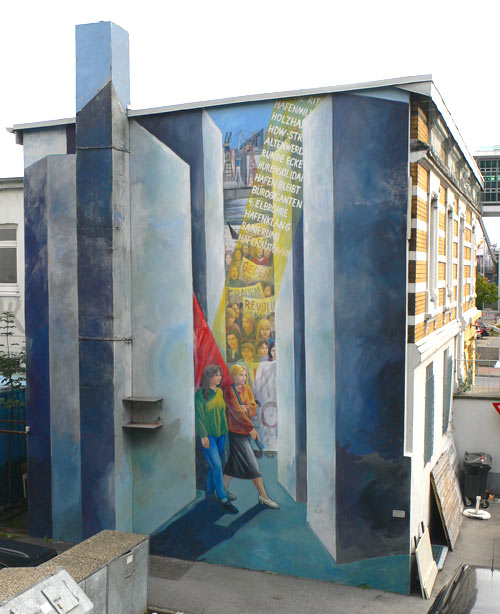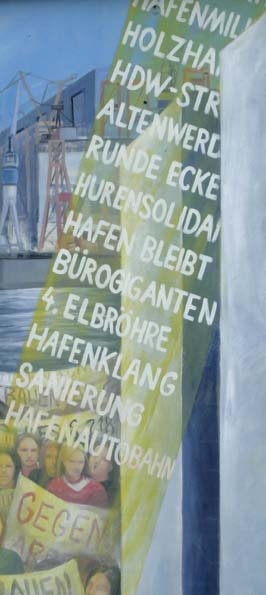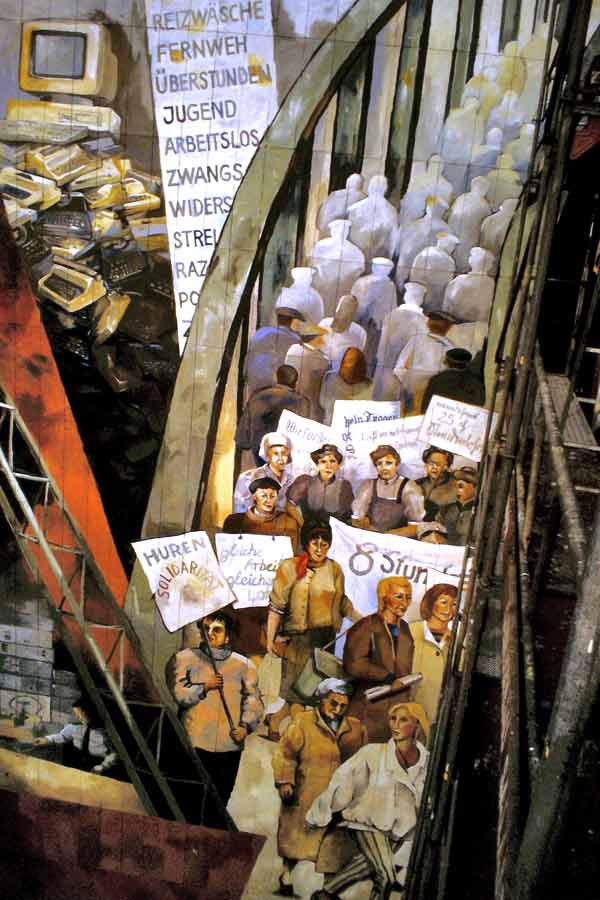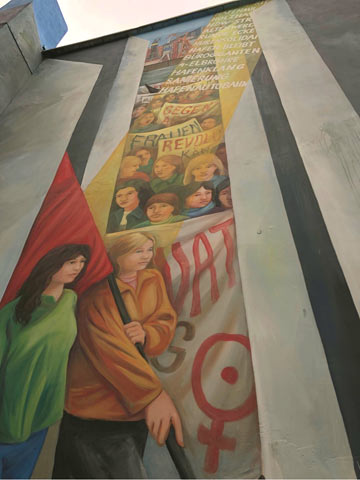The Demonstrators, 1997

"The Demonstrators"
Große Elbstraße 164, Rear wall.
Design: Cecilia Herrero. Realisation: Cecilia Herrero, Hildegund Schuster.
Sponsors: Women’s Working Party in the Museum of Work, R&S Baugesellschaft.
Photo: Hildegund Schuster ©
Life at the margins of the port has always been linked with altercation, controversy, resistance and political intervention in protest against poor working conditions for example, demolition of affordable housing, social cuts and state repression of alternative ways of living such as in the Hafenstraße. Dedicating an artistic memento in urban space to these movements was the intention of the eighth mural in the Women's Open Air Gallery Hamburg.
The artists Cecilia Herrero and Hildegund Schuster gave the memento the form of a vision: a bright yellow translucent ray of sunshine cuts through the grey buildings. Just like a portent, words can be detected on the sunbeam. They recall examples of conflicts in the port area since the 1960s and connect them with present-day reality by blending them with the words on the banners held by the demonstrators on the street.
When the mural was being painted, the so-called "chain of pearls" and its consequences were the cause of one of the most controversial debates in the whole of Hamburg. The expression goes back to Hamburg's former Chief Planning Director Egbert Kossack and the idea he had in 1985 of "revitalising" the northern bank of the river Elbe. This led to the gentrification of the port margins, turning it into an area of expensive apartments and offices. Meanwhile approx. 1.2 million square metres of office space are vacant.(1)

Photo: Dörte Schmidt-Reichard
The word strips in the mural with expressions such as timber port, save the port, giant office blocks, port sounds, refurbishment or port motorway recall the stages in this development, always accompanied by a range of left-wing, green and autonomous protest movements in the city and in the margins of the port.
"Altenwerder" recalls the village on the southern Elbe that has been destroyed in the course of port expansion step by step since the 1970s. "HDW strike" refers to the dramatic decline of the shipyards that culminated with more than 3,500 employees of Howaldtswerke-Deutsche Werft in Hamburg being made redundant, followed by the shipyard being occupied in September 1983.
"Solidarity among whores" recalls the support group "Solidarity for Hamburg's whores" that was founded by prostitutes in the city.(2)
The figures of the two young women, one blond and one dark-haired as representatives from the south and the north, emerge from a gap in the grey city wall holding the red flag as a political symbol of hope and appear to put themselves at the head of the protest march. They symbolise the important role that women play in political and social movements, a role often ignored in the annals of history. and they cast long shadows in the stage-like foreground of the picture, indicating that they intend to be involved in shaping the future with their political actions and interventions.
The mural also makes reference to the destroyed women's mural from 1989. It recalls the scene of a massive march by demonstrators across a typical port bridge to the river bank, as a "historical demonstration march" practically arising out of the "dark side of history". The words on the banners showed what moved women in the working world of the port and formed a link with the present day.
The top part of the picture gives an angled view of the actual focus, practically concealed by the mighty walls of the city: it's all about the port as a workplace.
© Elisabeth von Dücker, 2011
(1) "Vacant offices – housing shortage", hamburg-heute.de, 16/9/2010.
(2) Liliana von Rönn talks to Elisabeth von Dücker in December 2004, the interview can be found in: Elisabeth von Dücker, Beate Leopold, Christiane Howe, Museum of Work (publisher): "Sex work: a world of its own". Berlin 2008, p. 190 et seq.

Detail of the mural dated 1989
Photo: Britt Stranzen ©

Strikers in the urban jungle
Photo: Elisabeth von Dücker ©

The artists Cecilia Herrero and Hildegund Schuster
at work restoring the mural
Photo: Elisabeth von Dücker ©

Restoring the complete mural in August 2019
Photo: Elisabeth von Dücker ©

